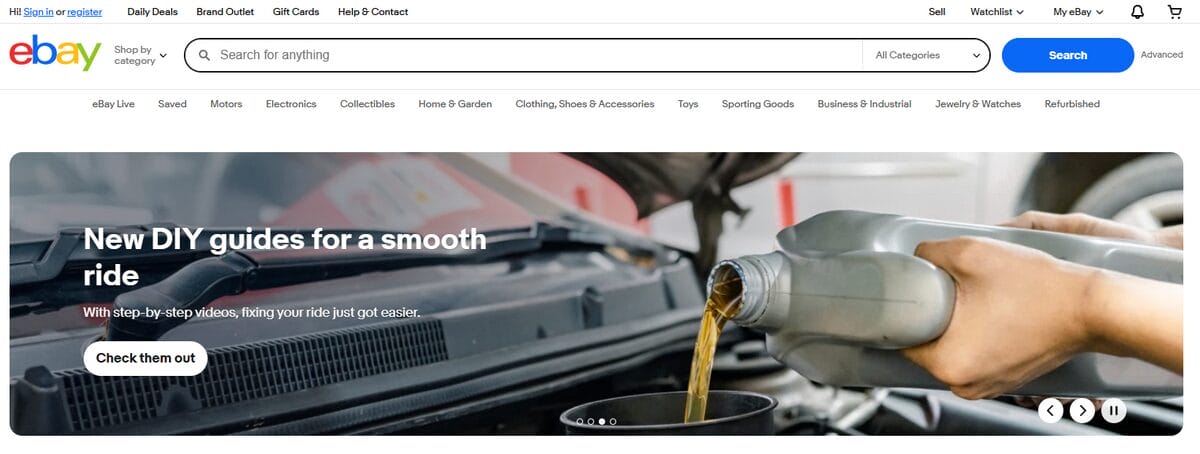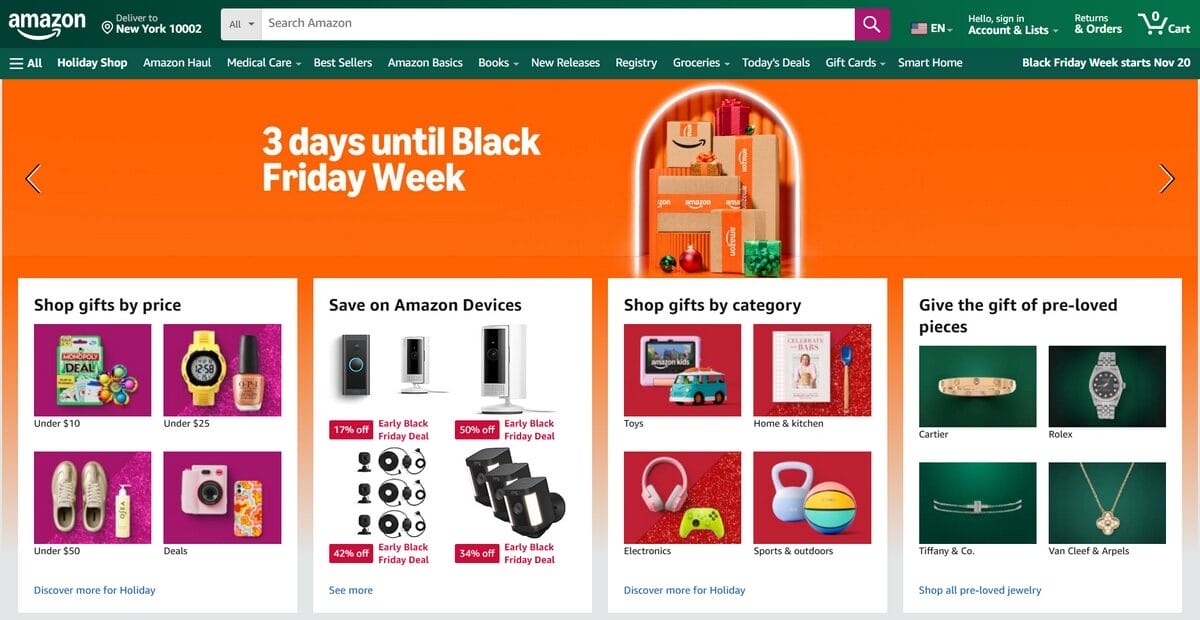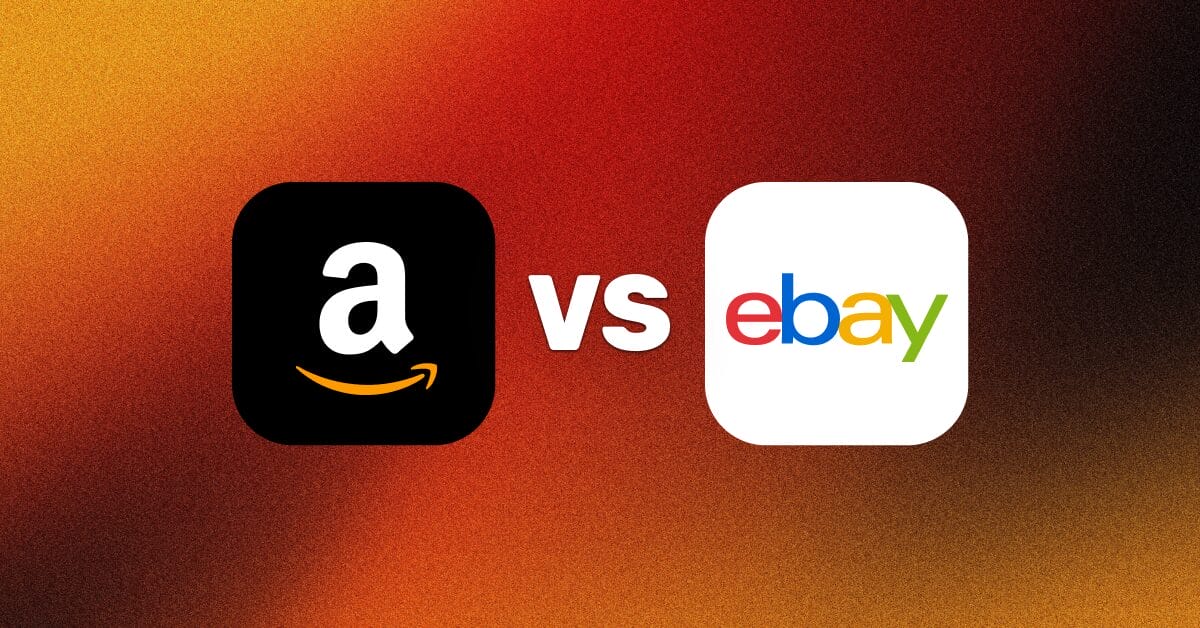Comparing Amazon vs. eBay is essential not only to understand the strengths and weaknesses of each platform in terms of dropshipping capabilities, but also to learn certain criteria that are very useful when choosing the tools to shape our online store.
Amazon or eBay? Which one offers better profit margins? Which is safer for building a scalable dropshipping business? What are the key features of each? In this article, we will delve into this comparison to help you choose the option that best suits your goals.
Additionally, we will examine how each platform operates when integrated with automation tools like AutoDS. AutoDS simplifies the landscape for dropshippers by automating tedious and time-consuming tasks that can be handled more efficiently, leading to better results.
eBay offers greater flexibility and lower costs.
Amazon has massive traffic and stronger customer trust.
eBay has fewer entry barriers and more permissive policies.
Amazon provides a robust logistics infrastructure.
AutoDS optimizes both strategies by automating key tasks.
Understanding Amazon and eBay as Dropshipping Platforms
| Aspect | eBay | Amazon |
|---|---|---|
| Shipping & Fulfillment | Sellers handle shipping themselves or via third parties, leading to variable delivery times. | Fulfillment by Amazon (FBA) offers fast, reliable shipping with higher fees but better customer satisfaction. |
| Profitability | Potentially higher margins due to lower fees and pricing flexibility. Suitable for smaller sellers and niche products. | Generally solid margins but subjected to higher fees and intense competition. Better for larger scale operations. |
| Legal Policies | More lenient policies allowing dropshipping from wholesalers. Sellers must manage delivery times and refunds responsibly. | Strict policies with rules that dropshipping sellers must adhere to, including responsibility for shipment and customer service. Non-compliance can lead to account suspension. |
| Risks | Moderate risk of sanctions if policies are violated, but generally more forgiving. | Higher risk due to strict enforcement of rules and performance metrics. Account suspension can occur quickly. |
| Customer Base | Large and diverse, but smaller than Amazon. | Massive global audience with high trust, especially Amazon Prime members. |
To conduct an accurate Amazon vs. eBay comparison, we need to gain a deeper understanding of the essential functioning of each platform. We can’t just pick the one we “like better”; instead, a brief investigation is necessary. Yes, through both platforms, we can sell without holding inventory, but how they operate and what they expect from you as a seller are pretty different.
While eBay is a flexible marketplace ideal for testing, Amazon operates more like a buyer-dense ecosystem built to scale and make your business more consistent.
Luckily, you don’t have to put on your detective hat because I’m here to guide you. Let’s take an overview of both platforms:
How eBay works for dropshipping

eBay is an open marketplace that allows anyone to list products without owning inventory, offering a lower entry barrier and a thriving global market for secondhand, vintage, and niche products.
This makes eBay especially appealing for dropshippers who want to quickly test new dropshipping niches or sell unique items using flexible selling formats such as auctions or fixed-price listings.
What does this mean? On eBay, we control our listings, pricing, and fulfillment method, and can pivot quickly as we learn what sells.
Key features of eBay
- Low barrier to entry: simple account setup and fast listing workflow.
- Broad demand for new, used, refurbished, and niche products (great for trend testing).
- Auction and fixed-price formats, plus strong international reach.
- Flexible branding on listings (photos, descriptions, store layout).
- Lenient experimentation: easier to iterate on titles, pricing, and shipping options.
This means eBay will work better for you if you’re a beginner seller looking to validate ideas quickly, or if you’re aiming to develop in a niche of second-hand categories where uniqueness is essential.
eBay also works well for those who need more control over their listings and feel more comfortable managing their own fulfillment.
How Amazon Works for Dropshippers

Amazon dropshipping is slightly less flexible than eBay in the sense that, as dropshippers, we operate in a more regulated ecosystem with stricter fulfillment standards. We must adhere to rigorous tax compliance and customer service benchmarks.
This rigor has a huge upside: it provides key advantages if we’re focused on new products and building a solid brand that will last, by offering customers increasingly better shopping experiences.
Key features of Amazon
- Massive buyer pool with high purchase intent and strong search volume.
- Standardized product pages tied to ASINs; less control over branding and layout.
- Strict operational targets (on-time shipping, valid tracking, low defect rates).
- Clear paths to scale (Buy Box competition, FBA later if you transition).
- Robust review and policy environment that rewards consistency.
When is Amazon convenient for you? It depends, but generally, it’s beneficial if you have reliable suppliers and a catalog with stable demand. If you’re looking to scale and test models that will grow your business sustainably, this is the way to go.
In summary:
- Speed to test: eBay is faster; Amazon is slower but steadier once set up.
- Control over listings/branding: higher on eBay; more standardized on Amazon.
- Operational rigor: lighter on eBay; much stricter on Amazon.
- Buyer intent/scale: good on eBay; typically higher on Amazon.
Amazon VS eBay: Profitability Comparison
You can’t compare without deeply addressing the topic of profit margins. It all sounds nice, but how do we get better results? Although it’s somewhat relative and depends on our dropshipping strategies, we can break down an approximate profitability for each site:
Typical Margins
For dropshippers, eBay generally offers a profit potential ranging between 15% and 35%, primarily due to its flexible pricing structure and comparatively lower seller fees.
This flexibility enables sellers to experiment with pricing strategies and maintain a decent level of profitability, especially in niche or second-hand markets.
Amazon, however, typically sees average profit margins from 10% to 20% after accounting for FBA (Fulfillment by Amazon) fees and referral commissions. While Amazon customers tend to be less price-sensitive and often value faster shipping and a trusted brand experience, competition is fierce.
This competitive environment can compress margins unless sellers excel in branding, customer service, and efficient inventory management.
Spoiler: We can solve this with a little help from our friend automation!
Keep in mind, typical margins aren’t that far apart between the two platforms, but note that eBay’s upside usually comes from flexible pricing on niche/used inventory, while Amazon’s upside comes from scale once you can consistently hit performance targets.
Revenue Volume & Scalability
Amazon generally provides access to much higher sales volume given its enormous buyer base, extensive fulfillment infrastructure, and Prime membership, making it the go-to platform for sellers aiming to scale quickly. However, this comes with lower margins on average, requiring careful cost control and operational efficiency.
In contrast, eBay tends to have lower overall sales volume but offers greater pricing and operational flexibility, which can translate to higher margins per sale. Its lower barriers to entry and cost structure are advantageous for sellers who test multiple products or who want to operate with more autonomy.
🆕 Beginner’s Tip: If dropshipping on eBay is your thing, get your numbers in order with AutoDS’s eBay fee calculator!
AutoDS Saves the Day!
A promise is a promise! On both eBay and Amazon, platforms like AutoDS enable dropshippers to manage and scale their stores by automating product imports, price adjustments, inventory syncing, and order fulfillment, thereby reducing manual work and human errors, which ultimately leads to better profit margins, regardless of the chosen platform.
Amazon VS eBay: Legal & Policy Considerations

Special care here! Knowing the specific rules of each platform will help us avoid account bans and potential legal problems.
Let’s start here: how does each platform view dropshipping? On Amazon, dropshipping is allowed only if you are the seller of record. That means your name must appear on the invoice/packing slip.
Sellers must also comply with tax requirements and local business regulations. Amazon has increased enforcement in recent years, with automated systems flagging violations such as retail arbitrage or unauthorized reselling, leading to account suspensions for offenders.
In this regard, eBay is a bit more permissive since dropshipping from a wholesale supplier is allowed, but ordering from another retailer marketplace to ship to your buyer is not. You are responsible for timely delivery and customer satisfaction.
eBay strongly prohibits retail-to-customer fulfillment from other retailers and requires that shipments bear the seller’s branding without third-party invoices or packaging
Buyer protection & dispute framework
- Amazon’s A-to-z Guarantee covers timely delivery, item condition, and the return experience on seller-fulfilled orders; sellers are expected to authorize eligible returns and respond promptly to claims.
- eBay’s Money Back Guarantee applies to most transactions when items don’t arrive, arrive damaged/faulty, or don’t match the listing. Know what’s covered/excluded and keep tracking handy.
IP protection & listing ownership
- Amazon emphasizes brand/IP enforcement via Brand Registry and related programs to report counterfeits and protect listings. Registration generally requires an active registered trademark.
- eBay operates the VeRO program, allowing rights owners to remove infringing/counterfeit listings and publish their profiles, so sellers know how to comply.
Check products’ legality
Of course, each platform has its own standards for what can be sold and what cannot. Be sure to check both Amazon and eBay, as well as the categories you should avoid to prevent a suspension.
As we said, depending on the country in which you operate, you must comply with the taxes and obligations required by the relevant state regulations.
While dropshipping remains viable on both marketplaces, sellers must carefully navigate these evolving rules. Tools like AutoDS can help automate compliance tasks such as order processing, supplier communication, and real-time inventory syncing, reducing risk.
Understanding these legal and policy nuances is critical for running a sustainable dropshipping business on either Amazon or eBay in 2026.
Risk Comparison — Which Platform Is Safer?
It’s not about becoming paranoid and finding faults in everything, but knowing the risks associated with dropshipping on each platform will help us better understand how they work and also learn various ways to avoid these risks. Let’s review the main drawbacks you might face:
eBay Risks
As mentioned before, eBay is an open marketplace, which brings advantages but also associated risks. We may face policy strikes if the product location information does not match reality, which can affect buyer trust and search rankings.
Also, keep in mind that being in an open market means we operate in a competitive environment, where aggressive price undercutting can occur, potentially eroding our margins.
Another risk can arise from return abuse, where bad-faith customers exploit eBay’s buyer protection policies, resulting in losses. Finally, keep in mind that inconsistent supplier quality, especially when sourcing from multiple vendors, can lead to negative feedback and account issues if unmonitored.
📦 Supplier’s Tip: Access the private and supported suppliers network from AutoDS and forget sourcing problems! Trust and security guaranteed.
Amazon risks
Amazon enforces stricter seller performance standards, which can increase operational risk. Account suspensions for late shipments or unresolved customer complaints are common consequences for sellers who cannot meet Amazon’s high expectations.
Amazon’s complex tax rules and brand registry requirements add layers of administrative burden that we have to navigate carefully to avoid suspensions or legal troubles.
AutoDS Saves the Day (Again)
The good news is that for both eBay and Amazon, automation mitigates risks. AutoDS minimizes obstacles by automating inventory synchronization, dynamic repricing to stay competitive, and shipment tracking to ensure timely deliveries. These features reduce human error and instances of non-compliance, helping dropshippers maintain healthy seller metrics and avoid costly penalties.
Automation enables sellers to focus more on strategy and growth while mitigating the operational risks inherent to marketplace selling.
Let’s dive deeper into this in the following heading!
Using AutoDS for Amazon & eBay Dropshipping

Automation is the glue that binds all components of dropshipping, optimizing it and extracting the best from every aspect. AutoDS works as a comprehensive tool that automates various tasks that can become repetitive and time-consuming.
This way, whether you choose Amazon as your selling platform or opt for eBay, scalability will happen much faster. Let’s look at some of the main ways we can make a difference.
- Intuitive, functional dashboard: your mission control center. AutoDS provides a unified dashboard tailored for dropshippers operating stores on both Amazon and eBay. This all-in-one platform streamlines listing, monitoring, and order fulfillment across marketplaces, so you don’t have to juggle multiple systems.
- Supplier network: As mentioned before, AutoDS gives you access to more than 25 integrated suppliers, including giants like AliExpress, Walmart, and CJ Dropshipping, enabling a diverse and reliable product inventory. Additionally, you can utilize AutoDS warehouse services.
- Price & stock monitoring: Stock shortages or sudden price changes don’t affect our business thanks to this feature that keeps everything synchronized, so you don’t have to monitor everything 24/7. The ability to set specific parameters that automatically adjust prices to maintain competitiveness is part of the benefits.
- Side-by-side profit analytics: AutoDS also provides detailed profit analytics that compare your Amazon and eBay store performances side by side, empowering data-driven decisions. Its API-based listing upload system prevents manual input errors, ensuring accuracy and compliance with marketplace requirements.
💡 Pro Tip: Use AutoDS to A/B test the same product on Amazon versus eBay to identify where it performs better, optimizing your sales strategy and maximizing profitability.
These are just some of the advantages you can gain by automating your entire dropshipping process with AutoDS.
Many dropshippers on both eBay and Amazon are already enjoying the benefits of AutoDS! Check out the features with the 14-day trial for $1!
Frequently Asked Questions
Is dropshipping legal on Amazon and eBay?
Yes, dropshipping is legal on both platforms, but you must comply with each marketplace’s requirements. This includes using approved suppliers and being the seller of record responsible for customer service and returns. AutoDS integrates with verified suppliers and tools to ensure you meet these compliance standards safely.
Which platform is more profitable for dropshipping — Amazon or eBay?
eBay generally offers higher profit margins due to lower fees and more flexible pricing, while Amazon tends to generate higher sales volume but with slimmer margins after fees. Your best choice depends on your available capital, business scale, and how effectively you leverage automation tools.
Can I manage dropshipping on both Amazon and eBay using AutoDS?
Absolutely. AutoDS provides a single, unified dashboard allowing you to list products, sync inventory, adjust prices, and fulfill orders on both Amazon and eBay simultaneously, streamlining your operations and saving time.
What are the main risks involved in dropshipping on these platforms?
The key risks include policy violations, which can lead to account suspension, as well as supplier reliability issues affecting product quality and delivery times. Using AutoDS’s vetted supplier network and automation minimizes these risks by ensuring compliance and consistent performance.
Which software tools are recommended for dropshipping on Amazon and eBay?
AutoDS is highly recommended for full automation, including price syncing and order fulfillment across both marketplaces. For simpler, single-platform needs, tools like DSers and Yaballe provide effective alternatives focused on eBay or AliExpress dropshipping.
Choose the Right Supplier Strategy with AutoDS
Life and business are made of decisions! Yes, comparing Amazon vs. eBay is quite complicated. But keep in mind what we’ve discussed in this article.
On eBay, you can conduct low-risk testing and enjoy fairly flexible policies to get started. On Amazon, on the other hand, we have more tools to scale, but we need consistency and must comply with several serious rules.
What is certain is that whichever you choose, AutoDS will make the journey downhill. AutoDS streamlines eBay and Amazon dropshipping by providing a comprehensive suite of features that encompass compliance, automation, and profit tracking within a single system.
👉 Start your AutoDS trial and compare your Amazon vs. eBay results in real time!
But first, read the following articles!
















